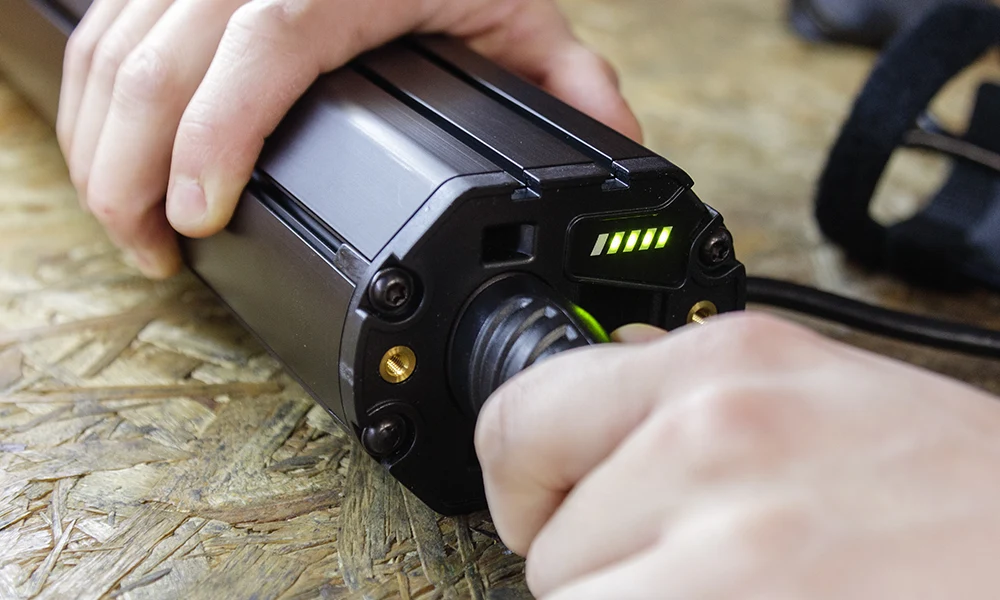6 TIPS ON STORING AND USING YOUR E-BIKE BATTERY IN WINTER
Learn more about how to store, charge or care for your e-bike and its battery in winter and what cold temperatures mean for the battery.
TAKE WINTER RIDES IN YOUR STRIDE WITH SIMPLE TIPS FOR PROTECTION AGAINST THE COLD
E-bikes are usually used less during the colder months of the year. But a lot of people still want to commute by e-bike or use it for leisure during the coronavirus pandemic. A few simple tips are all it takes to make your e-bike winterproof and your battery ready to go on tour.
WHY DO E-BIKE BATTERIES HAVE A SHORTER RANGE IN WINTER?
An e-bike is not worried by cold or wet conditions. Its frame and components are splash-proof and can cope with almost any temperature. A battery, on the other hand, does not like low temperatures. The frosty climate reduces its capacity and voltage, which in turn affects the range. But why is that? The lithium ions in e-bike batteries float in a liquid electrolyte. As the temperature drops, the electrolyte becomes more viscous and solidifies, reducing its conductivity. Consequently, the lithium ions migrate slower from anode to cathode and vice versa. A battery only produces around 50 % of its actual output at temperatures below -20°C. e-bikes are not for made for the polar circle.


THESE 6 TIPS WILL HELP YOU GET YOUR E-BIKE BATTERY THROUGH THE WINTER
Batteries are sensitive to extreme temperatures. Their ‘comfort zone’ is between 10 and 20 degrees Celsius. We thus recommend that you store the battery at room temperature and only fit it into your e-bike shortly before setting off.
1. Charging status and temperature
E-bike owners who think it is too cold to ride in winter should ideally store the battery between 10 and 20 degrees Celsius and keep the charge level between 50 and 80 % so that it doesn’t fall into deep sleep mode FIT batteries have a special «Storage level» mode that can be selected in the e-bike menu.
2. Take it easy
When temperatures drop, it is advisable to ease up a little. Choose a lower gear and a higher pedaling frequency. A cadence of 70 to 80 revolutions per minute (rpm) is ideal. Frequent starting and stopping burns more energy. Pedal as evenly as possible. This optimizes the e-bike battery’s range.
3. Different assistance levels
An e-bike has several assistance levels. The higher modes in particular should be used in winter. The higher discharge current heats up the battery because more assistance is provided for the motor. We too become warmer the more we move in cold weather.
4. Caring for your e-bike in winter
A well-oiled chain and the right tire pressure take some of the strain off the battery. A low tire pressure increases abrasion on hard surfaces, leading to a loss of speed. More energy is needed to reach the desired speed, but exactly the opposite is true on unpaved surfaces with a mountain bike. Carry out your winter check in autumn or make an appointment with your specialist dealer.
5. Charging the battery
A cold battery charges very slowly. It is better to take the battery indoors and charge it at room temperature. You should let the battery warm up before charging to prevent condensation. Condensation could interfere with the charge cycle or, at worst, damage it.
6. Packing the battery
Some manufacturers offer neoprene suits for their batteries so that they cool down slower. Contact your specialist dealer if you have any questions about this.
These tips help make the e-bike a comfortable means of transport in winter too, and extend its lifetime. Want to know more about batteries? The following article provides you with all the information you need:
26.10.2021

